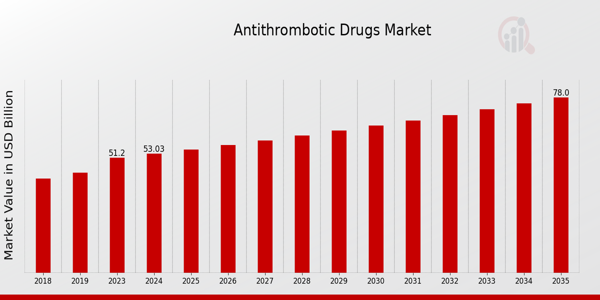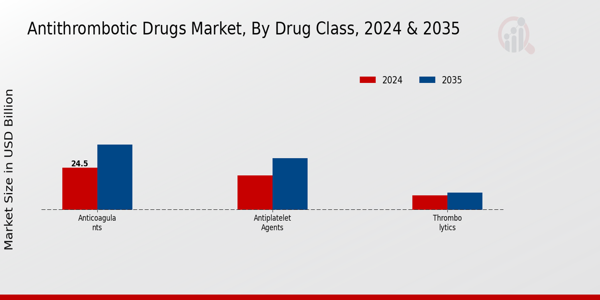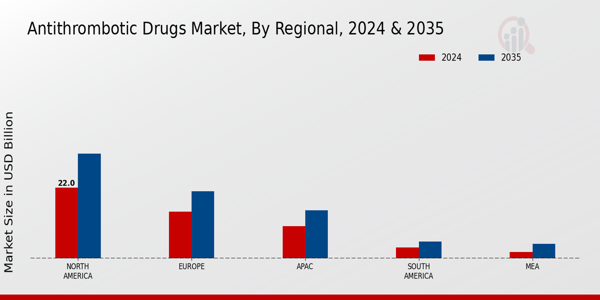Antithrombotic Drugs Market Overview
As per MRFR analysis, the Antithrombotic Drugs Market Size was estimated at 51.2 (USD Billion) in 2023. The Antithrombotic Drugs Market is expected to grow from 53.03 (USD Billion) in 2024 to 78.0 (USD Billion) by 2035. The Antithrombotic Drugs Market CAGR (growth rate) is expected to be around 3.57% during the forecast period (2025 - 2035).
Key Antithrombotic Drugs Market Trends Highlighted
The aging of the population and the rising incidence of cardiovascular disorders are driving the substantial expansion of the market for antithrombotic medications. Patients and medical professionals are looking for efficient antithrombotic treatments as a result of a rising understanding of the significance of preventing blood clots.
This need is further fueled by the increase in surgical operations and the corresponding necessity for anticoagulant therapy. Furthermore, improvements in drug formulations and delivery systems keep improving the safety and effectiveness profiles of these drugs, increasing their appeal to patients and doctors alike.
The creation of innovative antithrombotic medications that target particular patient groups is one of the market's opportunities. Personalized medicine is gaining traction, providing a path for tailored therapies that improve treatment outcomes. Regulatory incentives for the introduction of new drugs can also encourage innovation in the sector.
Moreover, expanding access to healthcare in emerging markets presents a significant growth avenue as more individuals are diagnosed and treated for thromboembolic disorders. Recent trends highlight a shift towards oral anticoagulants, which offer convenience over traditional therapies.
There has been a noticeable increase in the adoption of direct-acting oral anticoagulants (DOACs) due to their ease of use and minimal monitoring requirements.
Additionally, the integration of digital health technologies into treatment plans is reshaping patient management, facilitating remote monitoring, and improving adherence to medication regimens.
The focus on patient-centric approaches is driving a shift in how antithrombotic therapy is delivered, emphasizing efficiency and individual needs. Overall, the market is evolving rapidly, addressing both current challenges and future opportunities for growth.

Source: Primary Research, Secondary Research, MRFR Database and Analyst Review
Antithrombotic Drugs Market Drivers
Increasing prevalence of cardiovascular diseases
The surge in cardiovascular diseases globally is a significant driver for the Antithrombotic Drugs Market. With factors such as unhealthy lifestyles, poor dietary habits, and increasing rates of obesity, the prevalence of conditions like stroke and myocardial infarction has steadily risen.
As these diseases become more common, the demand for effective antithrombotic therapies to prevent thrombus formation and manage existing vascular conditions also rises. Given the expected growth in market valuation values, pharmaceutical companies are focusing on innovative antithrombotic drugs to address the growing health challenge presented by cardiovascular events.
Hospitals and healthcare providers are increasingly incorporating antithrombotic treatments into their protocols, resulting in higher consumption of these drugs. Moreover, awareness campaigns are pushing patients towards seeking preventive measures against thrombotic events, further bolstering the demand in the market.
Overall, the rising incidence of cardiovascular ailments creates an urgency for effective solutions, significantly contributing to the anticipated market growth.
Advancements in drug development and technology
The Antithrombotic Drugs Market is witnessing remarkable progress due to advancements in drug development and technology. Innovations in pharmaceuticals, such as the introduction of novel oral anticoagulants, have transformed treatment protocols.
These drugs provide advantages such as easier administration, lower risk of bleeding, and fewer dietary restrictions, making them popular among both healthcare providers and patients. Research and development investments are increasingly yielding new therapeutic options that are safer and more effective, catering to a broader patient demographic.
The embrace of biotechnology in drug formulation aims to reduce side effects and enhance patient compliance, which inevitably fuels the growth of the market. With regulatory bodies pushing for faster approval processes, there is a promising outlook for upcoming advancements, further defining the trajectory of the antithrombotic drugs landscape.
Growing aging population
The increasing aging population is another vital driver for the Antithrombotic Drugs Market. As age is a principal risk factor for various cardiovascular diseases, the rise in geriatric populations is directly linked to a heightened demand for antithrombotic therapies.
Older individuals are more susceptible to thrombotic complications, necessitating the use of antithrombotic medications for prevention and treatment. Healthcare systems are adapting to the needs of older adults, and there is an increasing focus on personalized medicine to cater to this demographic.
As more healthcare providers acknowledge the complexities associated with treating older patients, including polypharmacy and increased risk of drug interactions, the need for effective and safe antithrombotic solutions continues to grow. Consequently, the aging population is a significant factor influencing market dynamics and overall growth prospects.
Antithrombotic Drugs Market Segment Insights
Antithrombotic Drugs Market Drug Class Insights
The Antithrombotic Drugs Market was a vital component of the pharmaceutical industry, particularly focusing on the management and prevention of thrombotic disorders. The market was diversely segmented into multiple drug classes, with the most significant being Anticoagulants, Antiplatelet Agents, and Thrombolytics.
Within this segmentation, Anticoagulants emerged as a dominant player, with a market valuation of 24.5 USD Billion in 2024, expected to rise to 38.0 USD Billion by 2035. This drug class was crucial as it played a central role in preventing blood clots in patients with conditions like atrial fibrillation and deep vein thrombosis, highlighting its importance in clinical settings and its significant market growth potential.
Antiplatelet Agents also held a substantial share, valued at 20.0 USD Billion in 2024 and forecasted to increase to 30.0 USD Billion by 2035. These agents were essential in managing cardiovascular diseases by preventing platelets from clumping together, which was a key process in clot formation.
Their relevance was amplified as cardiovascular ailments continued to rise globally, leading to an increased demand for effective antiplatelet therapies.
Thrombolytics, although representing a smaller portion of the market with a valuation of 8.53 USD Billion in 2024 and a projected value of 10.0 USD Billion by 2035, were crucial for their role in the rapid dissolution of thrombi. Their application primarily focused on acute scenarios, such as myocardial infarction and stroke, underlining their importance despite the lower market share.
Each of these drug classes contributed to the overall revenue of the Antithrombotic Drugs Market, with Anticoagulants and Antiplatelet Agents dominating due to their widespread usage and essential function in preventing serious health conditions.
The ongoing research and development within the antithrombotic sector revolved around enhancing the efficacy and safety profiles of these drugs, driving market growth further while addressing the critical challenges of adverse effects associated with each drug class.
As the demographic landscape evolved and the prevalence of thrombotic disorders intensifies, the Antithrombotic Drugs Market adapted, promising significant growth opportunities and advancements. The data surrounding the Antithrombotic Drugs Market Statistics revealed an industry poised for innovation and expansion as it seeks to meet the growing healthcare demands effectively.

Source: Primary Research, Secondary Research, MRFR Database and Analyst Review
Antithrombotic Drugs Market Route of Administration Insights
The Antithrombotic Drugs Market has shown significant growth, focusing on the Route of Administration segment, which includes Oral, Injectable, and Intravenous methods. Among these routes, Oral administration is widely preferred due to its ease of use and patient compliance, making it a dominant choice in market trends.
Injectable routes, on the other hand, are recognized for their rapid effects and are often used in hospital settings, which is crucial for acute care scenarios. Intravenous administration remains significant for providing immediate therapeutic effects and is essential in emergency protocols.
The diverse needs and preferences of patients and healthcare providers are driving innovation and expanding the Antithrombotic Drugs Market segmentation. As the market moves toward 2035, a substantial growth trajectory is projected, offering numerous opportunities for advancements in drug formulations and delivery methods.
As such, the Route of Administration segment is pivotal in shaping the future landscape of the Antithrombotic Drugs Market, emphasizing the importance of accessibility and effectiveness in patient care.
Antithrombotic Drugs Market Therapeutic Area Insights
The Antithrombotic Drugs Market in the Therapeutic Area is poised for significant growth. Key segments within this market include cardiovascular disorders, stroke management, and peripheral artery disease, which play crucial roles in the treatment landscape.
Cardiovascular disorders often dominate the market due to the high prevalence of heart-related conditions, driving demand for effective antithrombotic therapies. Stroke management follows closely, as it constitutes a leading cause of disability and mortality worldwide, thus highlighting its importance in healthcare protocols.
Peripheral artery disease remains significant, fueled by an aging population and associated lifestyle factors, which increases the need for targeted treatments.
Together, these areas contribute to the overall dynamics and revenue generation within the Antithrombotic Drugs Market, with the market growth being supported by advancements in drug development and an increased focus on preventive healthcare strategies.
The data reflects how evolving patient needs and ongoing innovations continue to shape the industry's trajectory, presenting opportunities for further exploration and investment in these therapeutic applications.
Antithrombotic Drugs Market Patient Demographics Insights
The Antithrombotic Drugs Market showcases a compelling landscape within the Patient Demographics segment, emphasizing the importance of tailored therapeutic options for varied age groups.
The Elderly population stands out, as this demographic is particularly susceptible to thrombosis-related conditions, necessitating a comprehensive approach to antithrombotic treatment. Adults also represent a significant portion, driven by lifestyle factors that lead to increased risk of cardiovascular diseases and associated complications.
The Pediatric population, though smaller, requires careful consideration due to the unique physiological factors impacting drug metabolism and efficacy. The increased focus on personalized medicine and the rise in awareness around cardiovascular health contribute to market growth.
However, challenges such as age group-specific contraindications and the need for extensive clinical trials in diverse populations present obstacles. As the industry evolves, opportunities arise in developing innovative formulations and personalized therapies that cater effectively to these distinct age demographics.
The continuous evolution captured through Antithrombotic Drugs Market revenue and statistics highlights the dynamic interplay between demographics and treatment approaches in this essential market sector.
Antithrombotic Drugs Market Regional Insights
The Antithrombotic Drugs Market revenue showed substantial growth across various regions. In 2024, North America dominated the market with a valuation of 22.0 USD billion, increasing to 32.5 USD billion by 2035, reflecting the region's significant healthcare expenditure and a high prevalence of cardiovascular diseases.
Europe followed with a valuation of 14.5 USD billion in 2024, reaching 20.8 USD billion in 2035, showcasing strong regulatory support for antithrombotic therapies. The APAC region, valued at 10.0 USD billion in 2024, witnessed rapid growth due to increasing investments in healthcare infrastructure, projected to rise to 15.0 USD billion by 2035.
South America and MEA accounted for smaller shares, valued at 3.5 USD billion and 2.03 USD billion, respectively, in 2024, reflecting emerging economies with less developed pharmaceutical sectors. However, these markets are expected to grow at a steady pace, driven by rising awareness and access to treatment.
The Antithrombotic Drugs Market data revealed that market growth was challenged by the high cost of advanced therapies and a need for improved healthcare access in underdeveloped regions yet presented opportunities for market entrants and innovative solutions.

Source: Primary Research, Secondary Research, MRFR Database and Analyst Review
Antithrombotic Drugs Market Key Players and Competitive Insights
The Antithrombotic Drugs Market is characterized by intense competition, primarily driven by the increasing prevalence of cardiovascular diseases, a growing aging population, and heightened awareness of thromboembolic disorders. This market comprises a range of pharmaceutical products designed to prevent and treat conditions related to blood clotting.
Competitive dynamics are influenced by several factors, including product innovation, pricing strategies, regulatory approvals, and partnerships with healthcare providers. The industry is marked by substantial investments in research and development as companies strive to bring new and more effective antithrombotic agents to market.
With an expanding portfolio of drugs and an emphasis on personalized medicine, players in this sector are continually seeking to enhance their market positioning and capture a larger share. Roche is a notable figure in the antitrombotic drugs Market, renowned for its robust presence and comprehensive range of products.
The company leverages its strong research and development capabilities to introduce innovative antithrombotic solutions that meet the evolving needs of patients and healthcare providers. Roche's commitment to quality and efficacy underpins its competitive advantage, allowing it to maintain strong relationships with healthcare professionals and institutions.
Additionally, the company has established a reputation for excellence in clinical trials, contributing to its successful product launches and adoption in the market. Roche's advanced distribution network and strategic partnerships further enhance its market presence, enabling the company to respond promptly to market demands and ensure accessibility of its antithrombotic drugs to a wide patient population.
Mylan, another key player in the Antithrombotic Drugs Market, has carved a niche for itself through its commitment to providing affordable healthcare solutions. The company is recognized for its generic and specialty pharmaceuticals, which cater to a diverse patient demographic experiencing thromboembolic conditions.
Mylan’s strategic focus on affordability and accessibility has allowed it to capture significant market share, especially in regions where cost-sensitive patients seek effective treatment options. The company continually invests in expanding its product offerings and enhancing its manufacturing capabilities, ensuring a steady supply of high-quality antithrombotic drugs.
Furthermore, Mylan's ability to forge partnerships with healthcare systems and pharmacies bolsters its distribution channels, ultimately contributing to its competitive standing in the increasingly dynamic landscape of the antithrombotic market.
Key Companies in the Antithrombotic Drugs Market Include
- Roche
- Mylan
- Amgen
- Johnson and Johnson
- Merck and Co
- Pfizer
- Bristol-Myers Squibb
- GlaxoSmithKline
- Boehringer Ingelheim
- AbbVie
- Sanofi
- Novartis
- AstraZeneca
- Gilead Sciences
Antithrombotic Drugs Market Developments
Recent developments in the Antithrombotic Drugs Market reveal significant activity among key players such as Roche, Mylan, Amgen, and Johnson & Johnson. Noteworthy advancements have been noted in the approval of new antithrombotic agents aimed at enhancing treatment options for patients with cardiovascular conditions.
Additionally, companies like Merck & Co and Pfizer are focusing on research to optimize existing compounds and decrease side effects, thereby aiming for increased market share. The market has seen fluctuations in valuations driven by mergers and acquisitions, particularly as Bristol-Myers Squibb and Novartis explore strategic partnerships to bolster their portfolios.
AstraZeneca has also been noted for its efforts to expand therapeutic options, which is anticipated to influence market dynamics positively. Companies such as Gilead Sciences and AbbVie are actively investing in development stages, contributing to a competitive landscape where innovation remains a critical focus.
The overall market growth reflects increased demand for effective antithrombotic treatments, with expectations of continued enhancements in patient care and drug efficacy through collaborative efforts within the industry. Such developments mark a period of transformation and potential growth within the Antithrombotic Drugs Market.
Antithrombotic Drugs Market Segmentation Insights
Antithrombotic Drugs Market Drug Class Outlook
- Anticoagulants
- Antiplatelet Agents
- Thrombolytics
Antithrombotic Drugs Market Route of Administration Outlook
- Oral
- Injectable
- Intravenous
Antithrombotic Drugs Market Therapeutic Area Outlook
Antithrombotic Drugs Market Patient Demographics Outlook
Antithrombotic Drugs Market Regional Outlook
- North America
- Europe
- South America
- Asia Pacific
- Middle East and Africa
| Attribute/Metric Source: |
Details |
| MARKET SIZE 2023 |
51.2(USD Billion) |
| MARKET SIZE 2024 |
53.03(USD Billion) |
| MARKET SIZE 2035 |
78.0(USD Billion) |
| COMPOUND ANNUAL GROWTH RATE (CAGR) |
3.57% (2025 - 2035) |
| REPORT COVERAGE |
Revenue Forecast, Competitive Landscape, Growth Factors, and Trends |
| BASE YEAR |
2024 |
| MARKET FORECAST PERIOD |
2025 - 2035 |
| HISTORICAL DATA |
2019 - 2024 |
| MARKET FORECAST UNITS |
USD Billion |
| KEY COMPANIES PROFILED |
Roche, Mylan, Amgen, Johnson and Johnson, Merck and Co, Pfizer, BristolMyers Squibb, GlaxoSmithKline, Boehringer Ingelheim, AbbVie, Sanofi, Novartis, AstraZeneca, Gilead Sciences |
| SEGMENTS COVERED |
Drug Class, Route of Administration, Therapeutic Area, Patient Demographics, Regional |
| KEY MARKET OPPORTUNITIES |
Growing geriatric population, Increasing prevalence of cardiovascular diseases, Advancements in personalized medicine, Expanding pipeline of novel therapies, Rising demand for home healthcare solutions |
| KEY MARKET DYNAMICS |
Increasing prevalence of cardiovascular diseases, Growing aging population worldwide, Advancements in drug formulations, Rising demand for preventive therapies, Expanding healthcare access in emerging markets |
| COUNTRIES COVERED |
North America, Europe, APAC, South America, MEA |
Frequently Asked Questions (FAQ) :
The Global Antithrombotic Drugs Market is expected to be valued at 53.03 USD Billion in 2024.
The market size for Anticoagulants is projected to reach 38.0 USD Billion by 2035.
North America is expected to dominate the Antithrombotic Drugs Market with a valuation of 22.0 USD Billion in 2024.
The Global Antithrombotic Drugs Market is anticipated to grow at a CAGR of 3.57% from 2025 to 2035.
The market value for Thrombolytics is projected to reach 10.0 USD Billion by 2035.
Major players in the market include Roche, Pfizer, Johnson & Johnson, and AstraZeneca among others.
The market size for Antiplatelet Agents is expected to be 20.0 USD Billion in 2024.
The Antithrombotic Drugs Market in Europe is projected to grow to 20.8 USD Billion by 2035.
In 2024, the Antithrombotic Drugs Market in South America is expected to be valued at 3.5 USD Billion.
The growth of the Global Antithrombotic Drugs Market is driven by increasing prevalence of thromboembolic disorders and advancements in drug development.
















